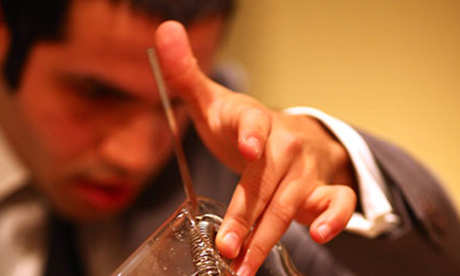Going stir crazy with absinthe friends

Drink up: A tasty sup at London Cocktail week. Photograph: Drinkup London
Both my Yorkshire grannies disapproved of drink; tea was what you had with meals, strong, sweet and milky. But when one of them in her somewhat scatty old age developed ‘palpitations’, she never left the house without an unlabelled glass medicine bottle, whose glorious red contents calmed her down when agitated, and perked her up when low.
The good doctor who prescribed her cherry brandy was acting in a long and honourable tradition, for the curative effects of fruit, herbs and spices, macerated or distilled with alcohol, have been appreciated since antiquity.
Medical theory and gastronomy went hand in hand in the olden days, when people thought the right choices of food and drink could keep you well or even make you better. Being ill meant that the balance of ‘humours’ was upset, but could be put right with food and drink and medicines that restored harmony to the system – much like today’s concept of holistic medicine. Sugar and spices were sold by apothecaries and used by cooks as well as physicians to give pleasure and heal. When they weren’t busy brewing real ale for their own use, medieval monks made making cordials and potions to cure the sick and comfort weary pilgrims: a fine tradition which gave us Benedictine, Chartreuse and many aromatic liqueurs.
Herbs, aromatic roots, and spices were put together in magical secret combinations, and this benign tradition lives on in the amari, aperitivi, digestivi, of Italy and France, marketed as being good for you at every stage in the meal.
And so they are, the irresistible combination of alcohol and a bitter sweet herby spiciness is both stimulating and settling.
If Her Majesty’s favourite tipple really is gin and Dubonnet, her longevity comes as no surprise.
New booze
Today cocktails are sipped pleasurably in this respectable comfort zone. You too can feel them doing you good, but there is the added frisson of danger remembering all the self-inflicted damage to bohemian poets and artists in nineteenth century Paris, of how Baudelaire and Nerval blew their minds on absinthe, the ‘green fairy’, a highly alcoholic drink flavoured mainly with fennel, aniseed and wormwood (the villain, once thought to be responsible for the mental and emotional confusion of Vincent van Gogh and many of his fellow artists).
Pernod and Ricard are the respectable versions of this lethal liquid, and get into many of the classic cocktails, but recently wormwood has come out of rehab and now the gentrification of absinthe is complete.
But Hackney citizens don’t have to go back to Montmartre to find an aromatic drink with a characteristic aniseed flavour. Raki, the national drink of Turkey, is available in food stores and restaurants all over the borough; diluted with water and ice cubes it makes a refreshing low alcohol drink, and can be enjoyed with food or on its own, with no fear of brain damage. Gallo Nero in Kingsland Road has a good range of Italian aperitivi and the convincingly wholesome Fernet Branca with its herby bitterness.
If you want something a little stronger, pay a visit to the Manhattan Project at Pond on Gillett Street, Dalston. Nothing but good can come of its Underwood cocktail, flavoured with absinthe, where the secret ingredient, beef bone marrow – added to the Sazerac recipe by innovative Hackney ‘cocktail entrepreneur’ Felix Cohen – gives a rich smooth meatiness to this traditional New
Orleans cocktail.
Cohen devised this cocktail to help his friend John Underwood, who is seriously ill with an aggressive form of blood cancer, hoping that it would cheer him up and make the rest of us aware of how we can all help to contribute to treatment for this terrible condition by giving a marrow transplant, as easy as giving blood.
Don’t let the bone marrow put you off. It is delicious, as you can discover at St John Bread and Wine in Shoreditch, where the unctuous contents of a freshly roasted veal or beef marrow bone can be enjoyed with salt and a simple parsley salad.
Enjoy the Underwood cocktail during London Cocktail Week, 5 – 11 October.
